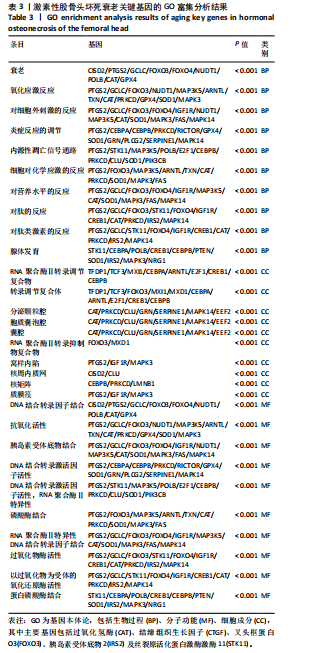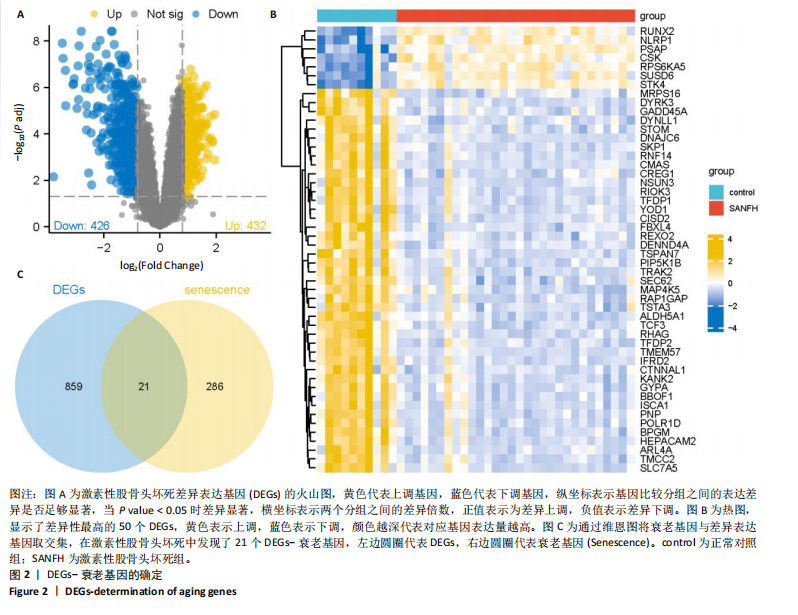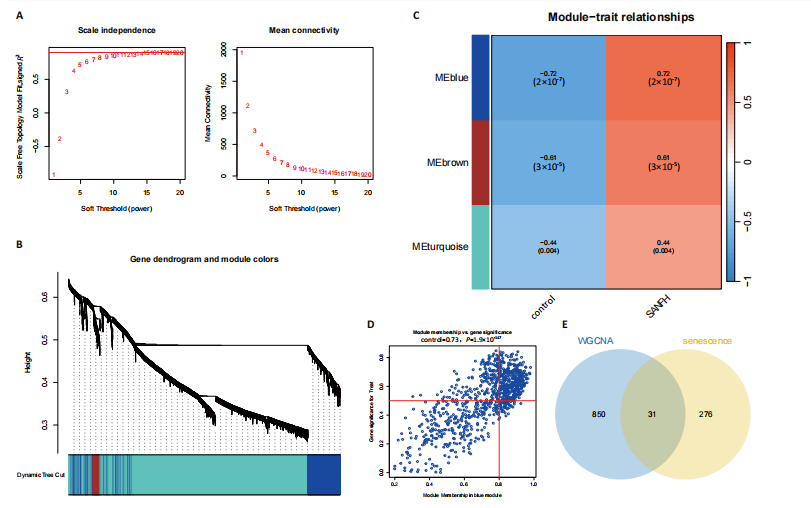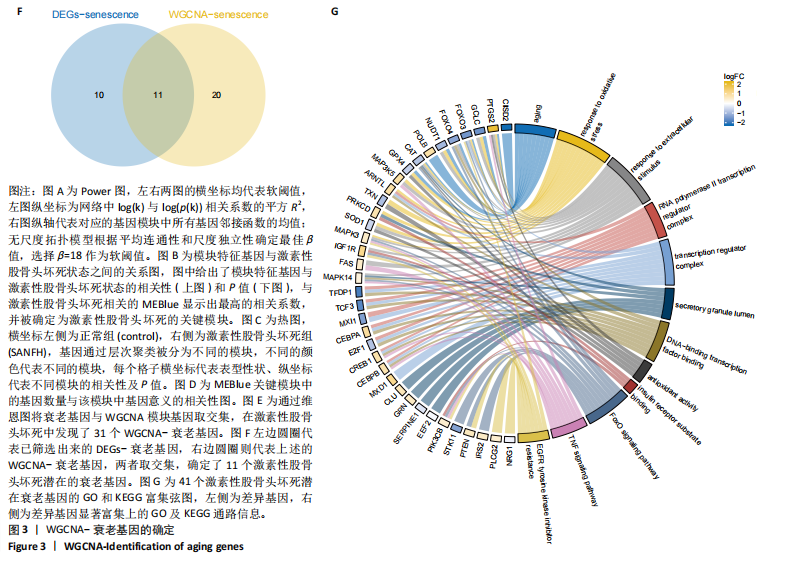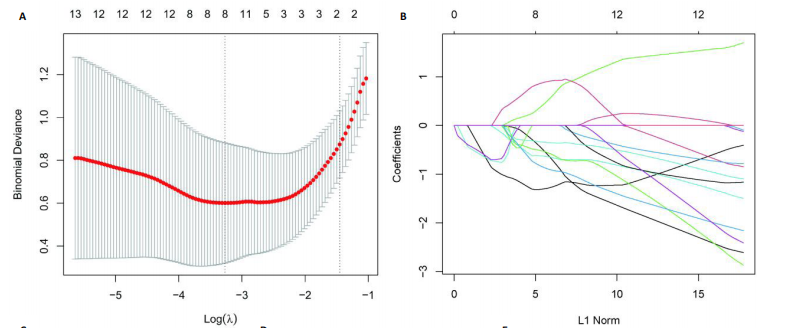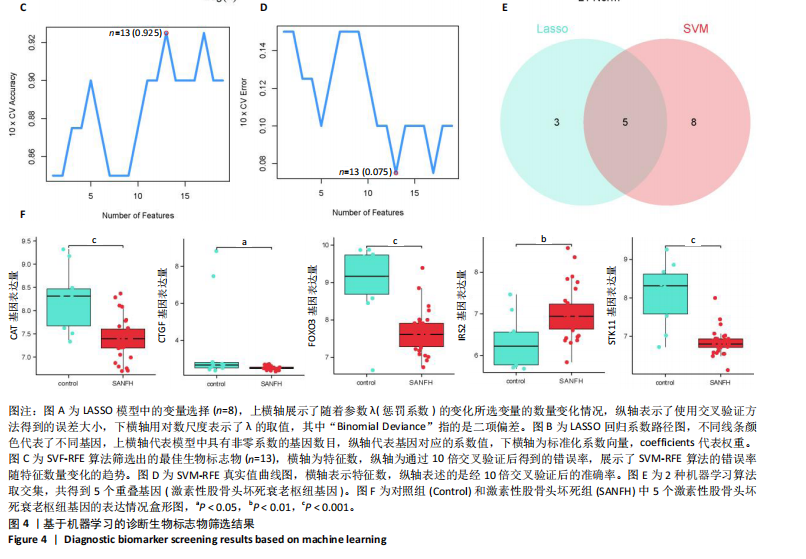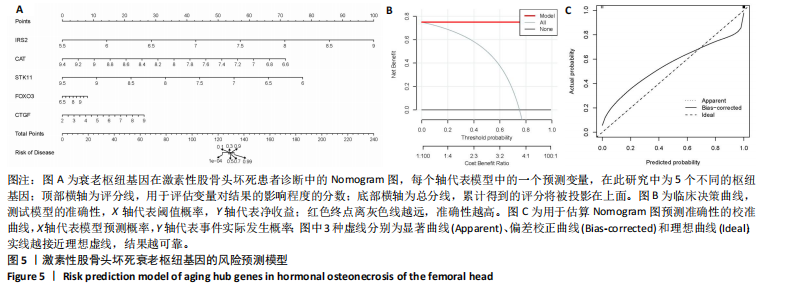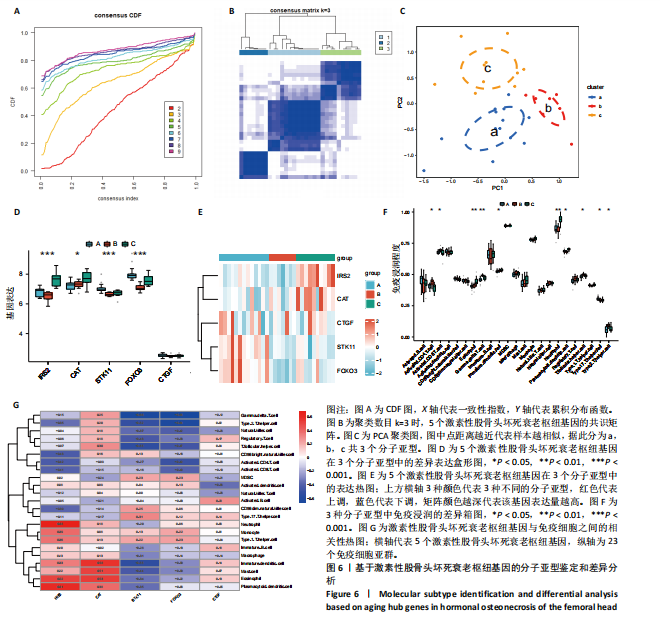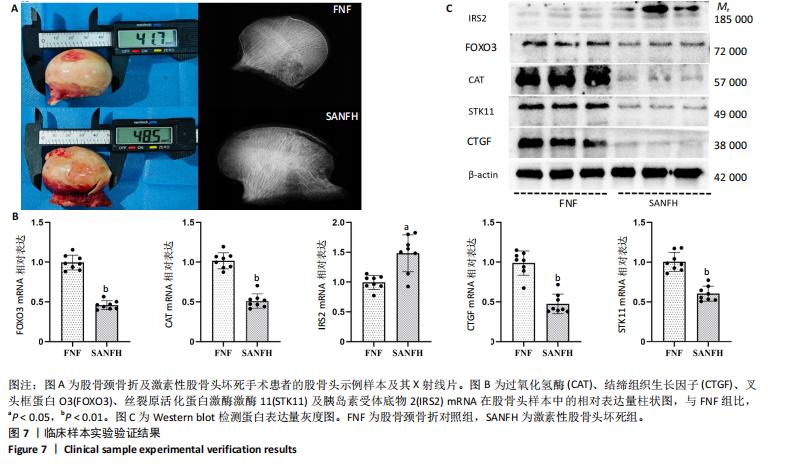[1] ZHANG J, CAO J, LIU Y, et al. Advances in the pathogenesis of steroid-associated osteonecrosis of the femoral head. Biomolecules. 2024; 14(6):667.
[2] LIJC, LIANG XZ, LUO D, et al. Study on the molecular mechanism of BuShenHuoXue capsule in treatment of steroid-induced osteonecrosis ofthefemoral head. Ann Transl Med. 2020;8(24):1680.
[3] LUCAS V, CAVADAS C, AVELEIRA CA. Cellular senescence: from mechanisms to current biomarkers and senotherapies. Pharmacol Rev. 2023;75(4):675-713.
[4] LI X, LI C, ZHANG W, et al. Inflammation and aging: signaling pathwaysand intervention therapies. Signal Transduct Target Ther. 2023;8(1):239.
[5] FULOP T, LARBI A, PAWELEC G, et al. Immunology of aging: the birth of inflammaging. Clin Rev Allergy Immunol. 2023;64(2):109-122.
[6] MOERMAN EJ, TENG K, LIPSCHITZ DA, et al. Aging activates adipogenic and suppresses osteogenic programs in mesenchymal marrow stroma/stem cells: the role of PPAR-gamma2 transcription factor and TGF-beta/BMP signaling pathways. Aging Cell. 2004;(6):3.
[7] CHEN H, LIU X, CHEN H, et al. Role of SIRT1 and AMPK in mesenchymal stem cells differentiation. Ageing Res Rev. 2014;(13):55-64.
[8] TANG B, CHEN Y, ZHAO P, et al. MiR-601-induced BMSCs senescence accelerates steroid-induced osteonecrosis of the femoral head progression by targeting SIRT1. Cell Mol Life Sci. 2023;80(9):261.
[9] TRAN KA, KONDRASHOVA O, BRADLEY A, et al. Deep learning in cancer diagnosis, prognosis and treatment selection. Genome Med. 2021;13(1):152.
[10] WALJEE AK, WEINHEIMER-HAUS EM, ABUBAKAR A, et al. Artificial intelligence and machine learning for early detection and diagnosis of colorectal cancer in sub-Saharan Africa. Gut. 2022;71(7):1259-1265.
[11] GREENER JG, KANDATHIL SM, MOFFAT L, et al. A guide to machine learning for biologists. Nat Rev Mol Cell Biol. 2022;23(1):40-55.
[12] ZHANG F, PENG WX, WANG L, et al. Role of FGF-2 transfected bone marrow mesenchymal stem cells in engineered bone tissue for repair of avascular necrosis of femoral head in rabbits. Cell Physiol Biochem. 2018;48(2):773-784.
[13] AVELAR RA, ORTEGA JG, TACUTU R, et al. A multidimensional systems biology analysis of cellular senescence in aging and disease. Genome Biol. 2020;21(1):91.
[14] LI Y, LU S, LAN M, et al. A prognostic nomogram integrating novel biomarkers identified by machine learning for cervical squamous cell carcinoma. J Transl Med. 2020;18(1):223.
[15] LI G, LI X, YANG M, et al. Prediction of biomarkers of oral squamous cell carcinoma using microarray technology. Sci Rep. 2017;7:42105.
[16] KANEHISA M, FURUMICHI M, SATO Y, et al. KEGG: integrating viruses and cellular organisms. Nucleic Acids Res. 2021;49(D1):D545-D551.
[17] SIMON N, FRIEDMAN J, HASTIE T, et al. Regularization paths for Cox’s proportional hazards model via coordinate descent. J Stat Softw. 2011; 39(5):1-13.
[18] CHEN D, LIU J, ZANG L, et al. Integrated machine learning and bioinformatic analyses constructed a novel stemness-related classifier to predict prognosis and immunotherapy responses for hepatocellular carcinoma patients. Int J Biol Sci. 2022;18(1):360-373.
[19] CHEN T, ZHANG H, LIU Y, et al. EVenn: Easy to create repeatable and editable Venn diagrams and Venn networks online. J Genet Genomics. 2021;48(9):863-866.
[20] WILKERSON MD, HAYES DN. ConsensusClusterPlus: a class discovery tool with confidence assessments and item tracking. Bioinformatics. 2010;26(12):1572-1573.
[21] BARBIE DA, TAMAYO P, BOEHM JS, et al. Systematic RNA interference reveals that oncogenic KRAS-driven cancers require TBK1. Nature. 2009;462(7269):108-112.
[22] SUO J, SHAO R, YANG R, et al. Accelerated aging in articular cartilage by ZMPSTE24 deficiency leads to osteoarthritis with impaired metabolic signaling and epigenetic regulation. Cell Death Dis. 2023;14(5):336.
[23] OKAMOTO M, NAKASHIMA H, SAKAI K, et al. Cellular senescence is associated with osteonecrosis of the femoral head while mesenchymal stem cell conditioned medium inhibits bone collapse. Sci Rep. 2024; 14(1):3329.
[24] CHEN X, GONG W, SHAO X, et al. METTL3-mediated m6A modification of ATG7 regulates autophagy-GATA4 axis to promote cellular senescence and osteoarthritis progression. Ann Rheum Dis. 2022;81(1):87-99.
[25] BAKER A, LIN CC, LETT C, et al. Catalase: a critical node in the regulation of cell fate. Free Radic Biol Med. 2023;199:56-66.
[26] ABDALBAGEMOHAMMEDABDALSADEG S, XIAO BL, MA XX, et al. Catalase immobilization: current knowledge, key insights, applications, and future prospects - A review. Int J Biol Macromol. 2024;276(Pt 2): 133941.
[27] NDREPEPA G. Myeloperoxidase – A bridge linking inflammation and oxidative stress with cardiovascular disease. Clinica Chimica Acta. 2019;493:36-51.
[28] SALMINEN A.Immunosuppressive network promotes immunosenescence associated withaging and chronic inflammatory conditions. J Mol Med (Berl). 2021:99(11):1553-1569.
[29] HU K, SHANG Z, YANG X, et al. Macrophage Polarization and the Regulation of Bone Immunity in Bone Homeostasis. J Inflamm Res. 2023;16:3563-3580.
[30] CHIANG CC, CHENG WJ, KORINEK M, et al. Neutrophils in psoriasis. Front Immunol. 2019;10:2376.
[31] COWLAND JB, BORREGAARD N. Granulopoiesis and granules of human neutrophils. Immunol Rev. 2016;273(1):11-28.
[32] CALNAN DR, BRUNET A. The FoxO code. Oncogene. 2008;27(16): 2276-2288.
[33] OMOROU M, HUANG Y, GAO M, et al. The forkhead box O3 (FOXO3): a key player in the regulation of ischemia and reperfusion injury. Cell Mol Life Sci. 2023;80(4):102.
[34] CAO G, LIN M, GU W, et al. The rules and regulatory mechanisms of FOXO3 on inflammation, metabolism, cell death and aging in hosts. Life Sci. 2023;328:121877.
[35] ATASHI F, MODARRESSI A, PEPPER MS. The role of reactive oxygen species in mesenchymal stem cell adipogenic and osteogenic differentiation: a review. Stem Cells Dev. 2015;24(10):1150-1163.
[36] ADAM-VIZI V, CHINOPOULOS C. Bioenergetics and the formation of mitochondrial reactive oxygen species. Trends Pharmacol Sci. 2006; 27(12):639-645.
[37] GOMEZ-PUERTO M, VERHAGEN LP, BRAAT AK, et al. Activation of autophagy by FOXO3 regulates redox homeostasis during osteogenic differentiation. Autophagy. 2016;12(10):1804-1816.
[38] JEONG SG, CHO GW. Endogenous ROS levels are increased in replicative senescence in human bone marrow mesenchymal stromal cells. Biochem Biophys Res Commun. 2015;460(4):971-976.
[39] ZHOU T, YAN Y, ZHAO C, et al. Resveratrol improves osteogenic differentiation of senescent bone mesenchymal stem cells through inhibiting endogenous reactive oxygen species production via AMPK activation. Redox Rep. 2019;24(1):62-69.
[40] KANAZAWA I. Interaction between bone and glucose metabolism. Endocr J. 2017;64(11):1043-1053.
[41] LIAN WS, WU RW, CHEN YS, et al. MicroRNA-29a mitigates osteoblast senescence and counteracts bone loss through oxidation resistance-1 control of FoxO3 methylation. Antioxidants (Basel). 2021;10(8):1248.
[42] XI G, WAI C, WHITE MF, et al. Down-regulation of insulin receptor substrate 1 during hyperglycemia induces vascular smooth muscle cell dedifferentiation. J Biol Chem. 2017;292(5):2009-2020.
[43] ZHAO H, LIU F, JIA R, et al. MiR-570 inhibits cell proliferation and glucose metabolism by targeting IRS1 and IRS2 in human chronic myelogenous leukemia. Iran J Basic Med Sci. 2017;20(5):481-488.
[44] ZHANG H, WANG Z, LI Q, et al. IRTKS promotes osteogenic differentiation by inhibiting PTEN phosphorylation. Biomed Pharmacother. 2024;177:116872.
[45] LI B, WANG Y, LIU Y, et al. Altered gene expression involved in insulin signaling pathway in type II diabetic osteoporosis rats model. Endocrine. 2013;43(1):136-146.
[46] CLAASSEN H, SCHLÜTER M, SCHÜNKE M, et al. Influence of 17beta-estradiol and insulin on type II collagen and protein synthesis of articular chondrocytes. Bone. 2006;39(2):310-317.
[47] KELLNER K, SCHULZ MB, GÖPFERICH A, et al. Insulin in tissue engineering of cartilage: a potential model system for growth factor application. J Drug Target. 2001;9(6):439-448.
[48] CAI L, OKUMU FW, CLELAND JL, et al. A slow release formulation of insulin as a treatment for osteoarthritis. Osteoarthritis Cartilage. 2002;10(9):692-706.
[49] SHAO J, LIU S, ZHENG X, et al. Berberine promotes peri-implant osteogenesis in diabetic rats by ROS-mediated IRS-1 pathway. Biofactors. 2021;47(1):80-92.
[50] MIAO M, ZHANG Y, WANG X, et al. The miRNA-144-5p/IRS1/AKT axis regulates the migration, proliferation, and mineralization of osteoblasts: a mechanism of bone repair in diabetic osteoporosis. Cell Biol Int. 2022;46(12):2220-2231.
[51] SANO T, OCHIAI T, NAGAYAMA T, et al. Genetic reduction of insulin signaling mitigates amyloid-β deposition by promoting expression of extracellular matrix proteins in the brain. J Neurosci. 2023;43(43): 7226-7241.
[52] OCHIAI T, SANO T, NAGAYAMA T, et al. Differential involvement of insulin receptor substrate (IRS)-1 and IRS-2 in brain insulin signaling is associated with the effects on amyloid pathology in a mouse model of Alzheimer’s disease. Neurobiol Dis. 2021;159:105510.
[53] REN M, YAO S, CHEN T, et al. Connective tissue growth factor: regulation, diseases, and drug discovery. Int J Mol Sci. 2024;25(9):4692.
[54] SHEN YW, ZHOU YD, CHEN HZ, et al. Targeting CTGF in cancer: an emerging therapeutic opportunity. Trends Cancer. 2021;7(6):511-524.
[55] YU L, WEN H, LIU C, et al. Embryonic stem cell-derived extracellular vesicles rejuvenate senescent cells and antagonize aging in mice. Bioact Mater. 2023;29:85-97.
[56] NISHIDA T, EMURA K, KUBOTA S, et al. CCN family 2/connective tissue growth factor (CCN2/CTGF) promotes osteoclastogenesis via induction of and interaction with dendritic cell-specific transmembrane protein (DC-STAMP). J Bone Miner Res. 2011;26(2):351-363.
[57] PONS-TOSTIVINT E, LUGAT A, FONTENAU JF, et al. STK11/LKB1 Modulation of the immune response in lung cancer: from biology to therapeutic impact. Cells. 2021;10(11):3129.
[58] TRELFORD CB, SHEPHERD TG. LKB1 biology: assessing the therapeutic relevancy of LKB1 inhibitors. Cell Commun Signal. 2024;22(1):310.
[59] LI J, WANG Y, CHEN D, et al. Oral administration of berberine limits post-traumatic osteoarthritis development and associated pain via AMP-activated protein kinase (AMPK) in mice. Osteoarthritis Cartilage. 2022;30(1):160-171.
[60] ZHENG Y, TAO Y, ZHAN X, et al. Nuclear receptor 4A1 (NR4A1) silencing protects hepatocyte against hypoxia-reperfusion injury in vitro by activating liver kinase B1 (LKB1)/AMP-activated protein kinase (AMPK) signaling. Bioengineered. 2022;13(4):8349-8359.
[61] WANG P, MA T, GUO D, et al. Metformin induces osteoblastic differentiation of human induced pluripotent stem cell-derived mesenchymal stem cells. J Tissue Eng Regen Med. 2018;12(2):437-446.
[62] CHEN C, ZHAO X, LUO Y, et al. Imbalanced t-cell subsets may facilitate the occurrence of osteonecrosis of the femoral head. J Inflamm Res. 2022;15:4159-4169.
[63] ELSAYED R, KURAGO Z, CUTLER CW, et al. Role of dendritic cell-mediated immune response in oral homeostasis: a new mechanism of osteonecrosis of the jaw. FASEB J. 2020;34(2):2595-2608.
[64] WANG B, DONG Y, TIAN Z, et al. The role of dendritic cells derived osteoclasts in bone destruction diseases. Genes Dis. 2020;8(4): 401-411.
[65] OGAWA H, YOKATA S, HOSOI Y, et al. Methylprednisolone pulse-enhanced neutrophil extracellular trap formation in mice with imiquimod-induced lupus-like disease, resulting in ischaemia of the femoral head cartilage. Lupus Sci Med. 2023;10(2):e001042. |
